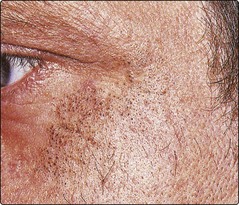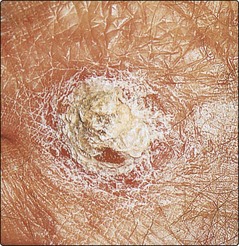Occupation and the skin
Skin disorders, after stress and musculoskeletal problems, are the commonest reported cause of occupational disease and are responsible for much lost productivity. An occupational dermatosis is defined as a skin condition that is primarily due to components of the work environment and would not have occurred unless the individual were doing that job.
Diagnosis
Proving a work association can be difficult. The following give clues:
 Contact with a known noxious agent.
Contact with a known noxious agent.
 Similar skin disease in other workers.
Similar skin disease in other workers.
 Consistent exposure-to-onset time course.
Consistent exposure-to-onset time course.
 Attacks appear with exposure, improve on withdrawal.
Attacks appear with exposure, improve on withdrawal.
 Site and type of eruption consistent with exposure.
Site and type of eruption consistent with exposure.
Contact dermatitis is the most common work-related skin disease and is more often irritant than allergic. Contact urticaria, particularly to latex, is now well recognized. Other occupational dermatoses are listed in Table 1. Certain infections, e.g. anthrax (p. 50), orf (p. 52) and tinea corporis (p. 58) may be occupational. Heat, cold, ultraviolet radiation, vibration and X-rays can cause industrial disease.
Table 1 Rarer occupational skin disorders
| Condition | Presentation | Occupational exposure |
|---|---|---|
| Argyria (Fig. 1) | Slate-grey pigmentation on face, hands, sclerae | Industrial processes, e.g. silver smelters |
| Chloracne (Fig. 2) | Multiple open and closed comedones on cheeks and behind ears | Halogenated aromatic hydrocarbons, e.g. contamination during manufacture |
| Occupational vitiligo (p. 74) | Symmetrical pigment loss on face and hands | Substituted phenols or catechols in oils, at coking plant |
| Tar keratoses (Fig. 3) | Small keratotic warts on face and hand, premalignant | Tar and pitch, e.g. road work or coking plant; UV is a co-carcinogen |
| Vibration white finger | Blanching and pain in digits, later swelling and impaired fine movement | Hand-held vibrating tools, as used by rock drillers or chainsaw operators |
Contact dermatitis
It is often difficult to differentiate between allergic and irritant causes.
Aetiopathogenesis
Many industrial substances are irritants and some are allergens as well (p. 34). Water, detergents, alkalis, coolant oils and solvents are important irritants. Common allergens include chromate, rubber chemicals, preservatives, nickel, fragrances, epoxy resins and phenol-formaldehyde resins (Table 2).
Stay updated, free articles. Join our Telegram channel

Full access? Get Clinical Tree






